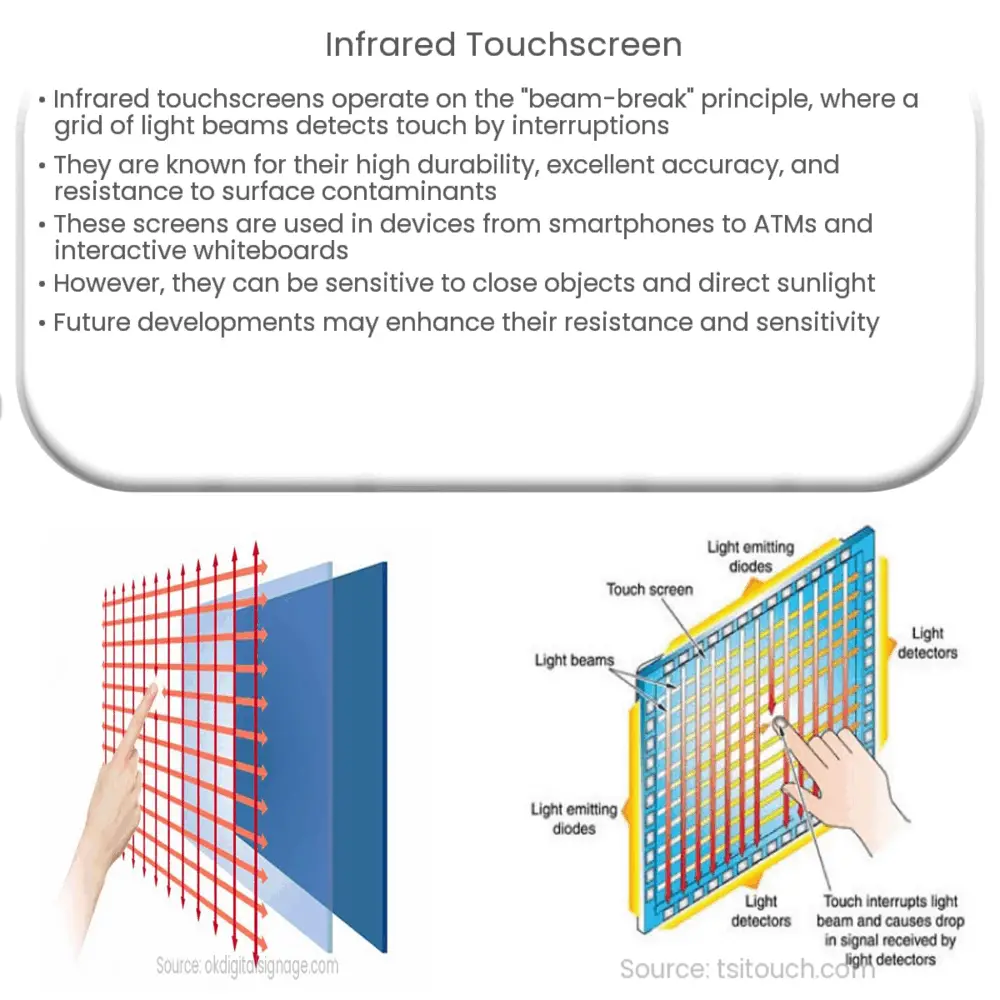Explore the world of Infrared Touchscreens, understand their working, advantages, limitations, applications, and future prospects.

Infrared Touchscreen: A Comprehensive Guide
The world of technology is evolving at an unprecedented rate, and one of the integral parts of this evolution is the touchscreen. Among various types of touchscreens, infrared technology has started gaining significant attention. Infrared touchscreens, known for their high level of accuracy and durability, have become quite popular in various sectors.
Understanding Infrared Touchscreen Technology
Infrared touchscreen technology operates on the principle of light-beam interruption, also known as “beam-break”, to detect touch. In essence, an array of X-Y infrared LED and photodetector pairs around the edges of the screen create an invisible grid of light. When an object, such as a stylus, finger, or other pointers, touches the screen, it interrupts the light beams. This interruption is then detected and processed into an X-Y location that is sent to the touchscreen controller and hence to the device for further processing.
Advantages of Infrared Touchscreens
- High Durability: Infrared touchscreens are not subject to wear and tear as there is no physical “touch” involved. This increases the lifespan of the devices, making them cost-effective in the long run.
- Excellent Accuracy: These screens offer high precision and can effectively detect multiple touch points at once, making them ideal for multi-touch applications.
- Insensitive to Surface Contaminants: Infrared touchscreens work effectively even when the screen is dirty or has surface contaminants, ensuring reliable operation in various environments.
Applications of Infrared Touchscreens
Infrared touchscreen technology is employed in a wide range of applications. From consumer electronics like smartphones and tablets to industrial controls, ATMs, interactive kiosks, and even in the medical field, the use of this technology is widespread. Let’s delve deeper into some key applications:
- Interactive Whiteboards: Due to their high precision and capability to handle multiple touch points, infrared touchscreens are often used in interactive whiteboards in educational institutions and corporate settings.
- ATMs and Self-Service Kiosks: The durability and reliability of infrared touchscreens make them an ideal choice for ATMs and self-service kiosks, which require robust and consistent performance.
In the following section, we will discuss more on the technical aspects, including the working mechanism, the benefits and limitations of infrared touchscreens, and the future prospects of this technology.
Technical Aspects of Infrared Touchscreens
The technical functioning of infrared touchscreens involves the intersection of infrared beams. An array of LEDs on one edge of the screen projects infrared beams to photodetectors on the opposite edge. This creates a grid of infrared beams across the screen. When a user touches the screen, they break the infrared beams at a specific point. The photodetectors then identify this change and transmit the X-Y coordinates to the controller for processing.
Limitations of Infrared Touchscreens
While infrared touchscreens offer numerous advantages, they also have certain limitations. For instance, they can be susceptible to accidental activation if an object comes too close to the screen, breaking the infrared beams. Additionally, direct sunlight or intense ambient light can interfere with the infrared sensors, affecting the performance of these screens.
The Future of Infrared Touchscreens
Infrared touchscreens have a promising future given their durable nature and high accuracy. With continual advancements in technology, we can expect improvements in infrared touchscreens that will make them even more reliable and versatile. Potential advancements include better sunlight resistance, improved multi-touch capabilities, and enhanced sensitivity to fine touch inputs.
Conclusion
Infrared touchscreen technology, with its unique blend of durability, accuracy, and adaptability, is making its mark in various fields. Despite a few limitations, its wide range of applications and the potential for future enhancements make it a promising avenue in touchscreen technology. As technology continues to evolve, so too will infrared touchscreens, bringing new possibilities and enhancements to our interactive experiences.

